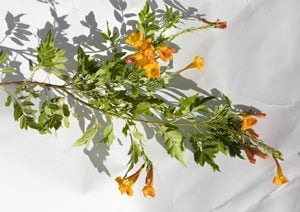The plant: It’s no mistake this plant was given a “jubilant” name. You’ll think you were invited to a joyous celebration as you watch this large, fast-growing shrub claim its spot in the garden. With lush green foliage and flashy orange flowers blooming most of the year, it looks like the party is always on. Better yet, it does best if left to grow in spots with full or reflected sun. It lives lightly on the land, only needing small amounts of water to thrive, and attracts beautiful hummingbirds. Orange Jubilee is also known as Orange Bells, Orange Trumpet Bush or Orange Esperanza. You’ll often find it growing next to its cousin, yellow bells (Tecoma stans). They both come from a family of showy shrubs called Tecomas. Orange Jubilee is believed to be a hybrid of a South African and Central American Tecoma having smaller, dark green leaves.
Growing guide: Full sun
Culture: Prepare soil for desert-adapted plants. Plant from transplant in spring. If planted in native soil without amendments, you’ll find it’s more tolerant of infrequent waterings. Those planted in richer soil would prefer more water. This upright shrub will grow up to 12 feet tall and spread up to 8 feet wide. Water every two to four days for the first few weeks, then once a week deeply during summer to establish. Orange Jubilee is moderately drought-tolerant, but will be full of flowers and remain lush during summer if supplemental water is added. If you live in an area where bunnies are a problem, a young plant should be protected. Once it grows above 3 to 4 feet it can usually survive visits from Thumper.
Maintenance: This is a laissez-faire plant, meaning it can be left alone to do its thing. That said, you’d most likely want to grab the pruners once or twice a season to contain or shape its fast-growing limbs. It’s best to do this during the warm growing months. It does produce seedpods, however Orange Jubilee produces fewer than other Tecoma varieties. You can cut faded flower blooms to lessen production of seedpods. It will tolerate a light frost, but will most likely sustain damage from the occasional hard freeze during the winter. In late winter or early spring, prune off the dead stems to allow for new growth. Even if the plant has sustained severe frostbite, it usually bounces back with new growth in spring. To reduce its leggy appearance, gardeners like to pinch off new top growth to encourage bush or side growth. Some choose to bring the entire plant down to 3 feet every few years in order to rejuvenate and reshape it. Yet another twist, some gardeners prune it into a sprawling vine.
Barn Goddess tips: Orange Jubilee is outstanding grown as a single specimen or harmonious when grown with other water-saving plants to create a mini, subtropical oasis. As a screen to cover a drab block wall or shade a west-facing window, or as a focal point to add drama, this plant won’t disappoint. Try combining it with the purple blooming chaparral and Mexican bush sages, then accent with orange- and red-hued calendulas, lantanas and zinnias. For a lush tropical oasis pair it with yucca vine, anacacho orchid tree, passion vine and red bird of paradise.
SOIL PREPARATION ADVICE FOR DESERT-ADAPTED PLANTS
Preparing soil for desert-adapted plants is different. Note the following hints for preparing the soil:
IN THE GROUND OR RAISED BED
Dig the planting hole three to five times wider than the pot, but only as deep as the pot. The roots of desert-adapted plants generally grow outward, not downward. Roughen the sidewalls of the hole--do not leave them slick and hard. This will encourage the roots to travel further outward instead of stopping. If the roots are “walled in”, it will be as if the plant is trapped in a pot, and the plant will become root-bound.
Rejoice--our native soil is good for these plants. While desert-adapted plants may not need organic matter, the soil does need to drain well. If you have heavy clay soil, add 25% of the volume in composted mulch (avoid mulches that contain peat moss) and add some gypsum. You don’t have to amend the backfill with organic matter, but Orange Jubilee will tolerate a rich soil if you are planting with non-desert adapted plants.









